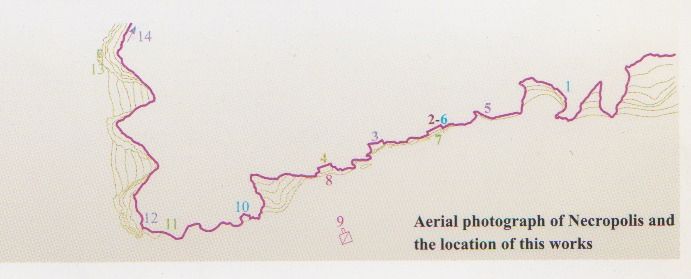Situated in province of Fārs, about a kilometer North West of Persepolis, Naqsh-e Rostam (the Relief of Rostam) is where the cubical structure called Ka’abe-ye Zartosht, four Achaemenid tombs and eight Sasanian rock reliefs are located. The rock reliefs show different Sasanians kings either in battle with their enemies or receiving legitimacy from gods. The site, consisting of a mountain face and a large flat area at its foot, was originally a sacred, or at least important, site for the Elamites and the Achaemenids. The former have left us a few reliefs of their own (some of which were carved over by the Sasanians) and the latter dominate the area with three large tombs, as well as the structure called Ka’abe-ye Zartosht.
What is probably the oldest of these Sasanians reliefs shows the founder of the dynasty, Ardashir (226 – 242) receiving a diadem from Ohrmazd. His son and successor Shapur I ( 242 – 271) also has his own relief in which he is depicting his dominance over three Roman Emperors. The other kings who appear in the reliefs of Naqsh-e Rostam are Bahram II (276-293), Narsē (293-303), Hormizd II (303-309) and Bahram IV. Aside from the kings and members of royal dynasty the only other person whose depiction we have in Naqsh-e Rostam is the high priest Kerdir who along with the carving of his face, give us a lengthy inscription about his deeds and actions.

5- Investiture of King Narseh, 2- Shahpur I and Valerian, 6- Detail of Shahpur’s relief, showing the Grand Priest Kerdir, 3. Jousting of King Hormizd II, 4/8- Two Sasanian kings jousting 11- Court of king Wahram II, 12- Investiture of Ardashir I, 13- Sasanian fire-altars
Bibliography
- Schmidt, Erich F. Persepolis, vol. 3, The Royal Tombs and Other Monuments, Chicago: University of Chicago, Oriental Institute Publications, 1970.
- MacKenzie, D. N. “Kerdir’s Inscription.” Iranische Denkmaler, II 13, Berlin, 1989, pp. 35-72.
- Gall, Hubertus von. Das Reiterkampjbild in der iranischen and iranisch beeinflussten Kunst parthischer und sasanidischer Zeit.
- Teheraner Forschungen, 6 Berlin, 1990. Herrmann, Georgina. Naqsh-i Rustam 6 and 8: Sasanian Reliefs Attributed to Hormuzd 11 and Narseh.
- Iranische Denkmaler, Iranische Denkmaler II 8. Berlin, 1977.
- Herrmann, Georgina. The Sasanian Rock Reliefs at Naqsh-i Rustam: Naqsh-i Rustam 6, The Triumph of Shapur I. Iranische Denkmaler, II 13. Berlin, 1989.
